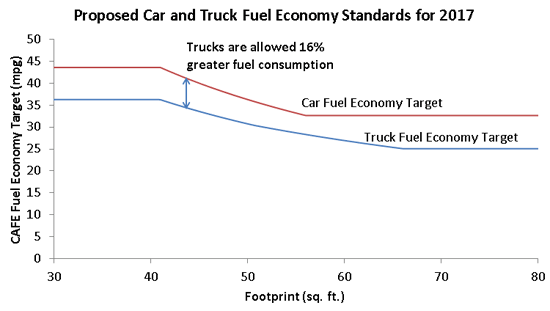When I was growing up, we called vehicles like the Honda CRV, the Toyota Rav4, and the Ford Escape “station wagons.” But that’s not very cool today, so instead they are called “crossover” vehicles—a mix between an SUV and a car.
These types of vehicles are pretty clearly intended to move people around on roads, not to carry manure or construction equipment or to navigate boulders in the back woods. Despite that, put 4-wheel drive (4WD) on a CRV and it gets classified as a “non-passenger vehicle,” or truck, while the 2-wheel drive (2WD) version is a “passenger vehicle,” or car under federal fuel efficiency and global warming pollution standards.
Not only does that not make sense, it makes for bad policy.
Different Standards Present an Opportunity for Gaming
Cars and trucks get separate treatment under the existing and proposed standards. There is some logic to this for real trucks: a vehicle that needs to tow thousands of pounds, haul gravel and other materials to a work site, and travel extensively off-road all the time are designed differently than ones used to move people, which can impact the amount of fuel they use. But the existence of separate standards, especially when it comes to crossovers, presents a potential loophole. As a result, the expected oil savings and emissions reductions—not to mention consumer savings—of fuel efficiency and global warming pollution standards proposed by the federal government could end up less than we expect.
Current Federal Regulations Definitions Allow for Funny Results
According to 2011 fuel economy data, the 4WD version of the CRV consumes 2-3% more fuel per mile than the 2WD version. The Ford Escape 2WD and 4WD shows similar differences.
But take a look at the gap in the proposed car and truck standards for 2017 (see figure). A vehicle like the 4WD Honda CRV, which qualifies as a truck with a footprint of about 44 sq. ft., has a fuel consumption target that is 16% higher than the 2WD version, which is classified as a car.

The large difference between the actual performance of 2WD vs. 4WD vehicles and the gap between the car and truck standards presents a potential opportunity for car companies. Shifting to more 4WD versions to meet a less stringent standard might be an attractive option for an automaker to make it easier to comply with the standards. Of course, that would mean someone who wants a 2WD crossover would not only be out of luck, they would be out several bucks as they’d be stuck spending more money on gas and polluting more.
Just because there is a potential for gaming the system, doesn’t mean it will happen. And maybe automakers won’t see this as an opportunity to meet weaker standards. But the risk is there nonetheless.
This is not a new problem. In fact, it used to be much worse. At one point, you didn’t even need 4 wheel drive, and even compact cars like the PT Cruiser could qualify as trucks. That part of the loophole got closed, but what’s left is still big enough to drive a crossover (station wagon) through.
It’s Time to Revisit the Definition of a Car vs. a Truck
I’m testifying on this very issue (and others) today at a public hearing in San Francisco on the proposed federal 2017-2025 fuel economy and greenhouse gas standards.
You can also push for strong fuel efficiency and global warming pollution standards for all cars and light trucks—and urge the EPA and DOT to take a closer look at what makes a car a truck—by submitting a comment on the proposed clean car standards. The comment period closes February 13 so take action today.

